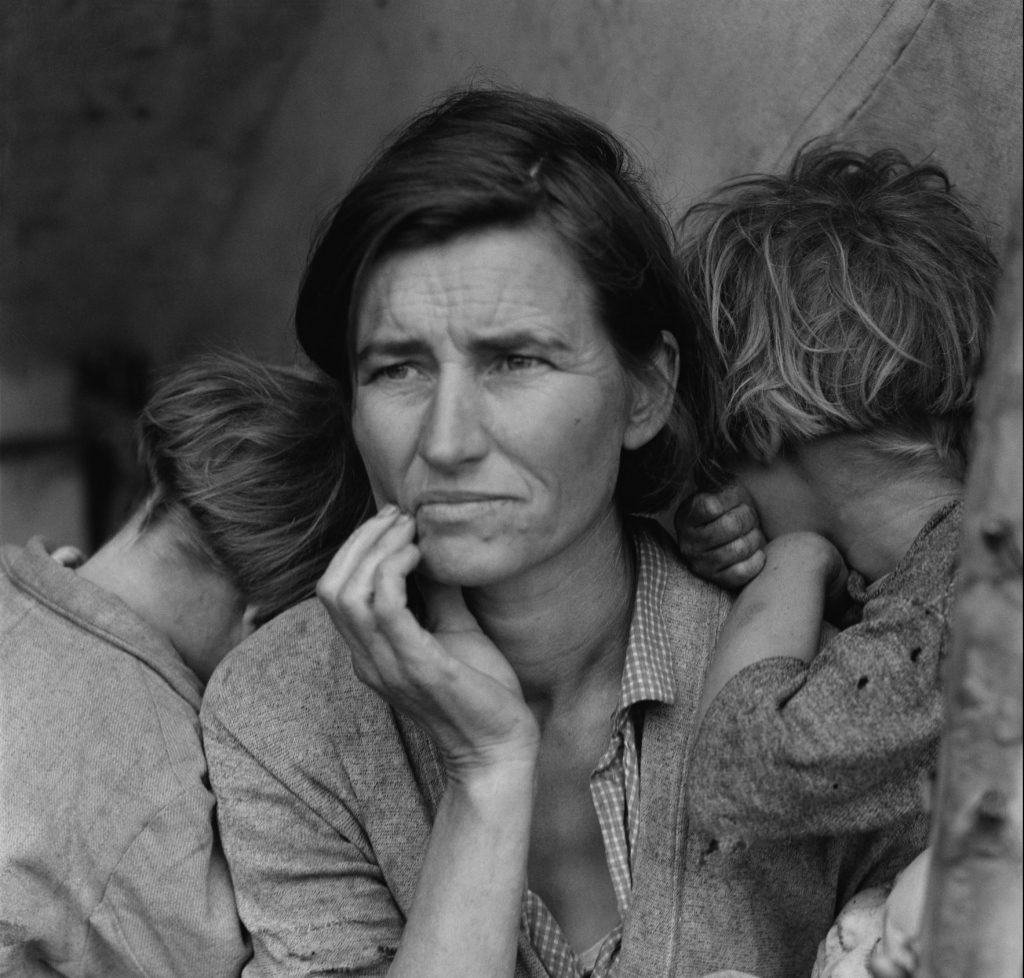What can a single image possibly say about our complex world? Of course, one picture can’t possibly capture everything. All of the tragedy and despair or all of the celebrations and joyful moments can hardly be captured in a million pictures. So, what difference can one picture really make? Documentary photographer, Dorothea Lange, set out with a simple goal in mind: to document the lives of the ordinary people in the world around her. In doing so, she inadvertently brought about drastic change through the increase of awareness of poverty and the conditions people were forced to endure. Lange influenced millions through the use of one single picture, and, that influence has and will continue for decades in the future.1
Lange found her life’s work and passion as a photographer in the 1930s, following the path of a common photographer in capturing people’s portraits and selling them to make a profit. While she enjoyed her work and was obviously very skilled, she always thought of herself as more of a historian than a true artist. As her career in portraiture continued, she improved her skills and came to open up a studio of her own in San Francisco, California. Here, she continued to perfect her craft, and she shared her talent with those among the wealthier classes of her society. It didn’t take long, however, for her to realize that her picture-taking skills could be used for much bigger, much greater, and overall, much more important things.2
In the midst of her successful portrait-focused career, the Great Depression struck and ravaged the lives of Americans far and wide. Lange, who originally, “would have thought it enough to take a picture of a man, nothing more,” quickly came to readjust her mindset upon seeing the pain in the world around her, and instead, decided that she “wanted to take a picture of a man as he stood in the world.”3 In 1933, a time in American history categorized by increasing tension and unbearable poverty in the lives of the average worker, Lange made what would come to be a life-changing decision: a drastic change in her creative mindset from elegant portraits to exposing the conditions of poverty. This single change in her life led her to become, undoubtedly, one of the most influential documentary photographers of the Great Depression.4

In May of 1935, with her newfound purpose of documenting the suffering around her, Lange became an employee of the Resettlement Administration (RA), later known as the Farm Security Administration (FSA). The goal of the RA was to bring to light the struggles of rural poverty in the country through the use of photographs. They found that sharing the conditions and hardships of life through photographs was much more impactful than any written reports, because the audience could see situations with their own eyes, which they may not have ever had the chance to see. The RA used this method of documentary photography because they recognized how powerful it could be and they needed to gain support for their projects. Lange’s job with the RA was demanding and required her to travel across the country to places that many had never heard of or even knew existed at all.5 Needless to say, she completed meaningful work and had many adventures throughout her time with the RA.

On one such adventure, on a rainy day in March of 1936, Lange had just finished another one of her photography excursions in California, and had packed up all of her equipment and supplies to begin her more than seven-hour drive home to her family. The drive started off dull and uneventful as she pushed ahead in the pouring rain. Occasionally, there were other cars and signs on the side of the road, but nothing out of the ordinary for the small San Luis Obispo County road. “PEA-PICKERS CAMP” one sign read. She considered stopping, thinking she would document more of the harsh conditions in the rural area, but instead, decided against it, knowing she still had a long trip ahead of her. While the sign and the camp became further and further behind her, they never left the forefront of her mind.
As she drove on, she thought to herself, questioning what could have been so special about that camp. It was just another pea-pickers camp, like the others she had already seen and taken pictures of. Why should she care about another one? It couldn’t possibly be that different from the ones she’d already seen. She would probably just drive in to find the same suffering and poverty she’d seen at the others. What difference would it make if she just drove past this one camp? Nobody even knew it existed anyway, so it wouldn’t make a difference, right? After getting lost in this inner argument, trying in every way possible to convince herself why she should not turn around, Lange almost unconsciously made a U-turn twenty miles past the sign and began to drive back to the camp.6
Upon reaching the camp that she had almost convinced herself to leave behind, Lange was drawn to one woman in particular. She didn’t ask for the woman’s name, or anything about her history or how she came to work at the pea-picker camp. Lange simply saw this kind of information as irrelevant to achieving her goal, which was to highlight the horrendous conditions and intense poverty of the Great Depression. While she didn’t learn much about the woman, she did learn that she was a mother of seven, living in a makeshift tent surviving mostly on frozen vegetables and small birds. The woman and Lange talked briefly, and then Lange proceeded to take a total of five pictures of the mother and several of her children, later saying, “There she sat in that lean-to tent with her children huddled around her, and seemed to know that my pictures might help her, and so she helped me. There was a sort of equality about it.” After spending a brief ten minutes at the camp, with the limited amount of information Lange had on her subjects, and a grand total of five pictures, Lange once again packed up her supplies and continued on her long trip back home.7

Lange’s intuition to turn her car around that day must have been very powerful. Deep down inside she must have known that her choice to go on or to turn around would make a profound difference in her story and in the lives of millions of those struggling around the world. That one, ten minute stop and those five pictures that Lange almost didn’t get the chance to take, later came to shape her entire career. Those pictures are the reason she is remembered to this day, the most famous being titled “Migrant Mother.” This image depicts the mother of seven that Lange met at the pea-picker camp, staring far off into the distance, seemingly lost in thought and isolated, even as she was surrounded by several of her children. Most, if not all, of Lange’s pictures had a recurring theme of separation from society, with an emphasis on the struggling classes and the pain that they had to endure on a daily basis.8 Lange’s “Migrant Mother,” however, displayed this theme so well that it became a symbol of the Great Depression as a whole. The image became an icon of the Great Depression and people in different cultures even began to replicate it to make it relevant to themselves. One picture gave the mother and children Spanish features, while still another gave them black features.9 Her work was so moving that it mirrored the isolated feelings of numerous cultures and became universally accepted and used to try and changed the way these people were being treated. Lange’s “Migrant Mother” slowly became one of the most recognizable and copied images in history.10
- Encyclopedia of the Great Depression, 2004, s.v. “Lange, Dorothea,” by Linda Gordon. ↵
- Allison McNeill et al., Great Depression and New Deal Biographies (Great Depression and the New Deal Reference Library: vol. 2: Biographies, UXL, 2003), 141-142. ↵
- David P. Peeler, Hope among Us Yet: Social Criticism and Social Solace in Depression America (Athens, Georgia: University of Georgia Press, 1987), 62. ↵
- Encyclopedia of the Great Depression, 2004, s.v. “Lange, Dorothea,” by Ed. Robert S. McElvaine. ↵
- Allison McNeill et al., Great Depression and New Deal Biographies, (Great Depression and the New Deal Reference Library: vol. 2: Biographies, UXL, 2003), 144-146. ↵
- Milton Meltzer, Dorothea Lange: A Photographer’s Life (New York, NY: Farrat, Straus & Giroux, 1978), 132-133. ↵
- Dorothea Lange, “The Assignment I’ll Never Forget: Migrant Mother,” Popular Photography February 1960, 1-2. ↵
- Melissa A. McEuen, Seeing America: Women Photographers between the Wars (Kentucky: The University Press of Kentucky, 2000), 110. ↵
- Judith Fryer Davidov, Women’s Camera Work: Self/Body/Other in American Visual Culture. (Durham, North Carolina: Duke University Press, 1998), 5-6. ↵
- Lawrence W. Levine, “The Historian and the Icon: Photography and the History of the American People in the 1930s and 1940s,” In Documenting America, 1935–1943, (Berkley: University of California Press, 1988), 16. ↵



140 comments
Maya Mani
This reminds me of the story of the Afghan girl. She was a symbol of the struggle taking place in her country. This is a similar scenario, and it is absolutely true that a picture is worth a thousand words. These photo’s convey emotions that are simply not expressive enough in words, they can truly become a wake up call.
Alexandra Lopez
Congrats on the nomination. The author’s use of images in this article were powerful to tell the story of suffering that was going on during the Great Depression. I do believe that a picture says a lot especially during times of hardship. I am glad Dorothea Lange made a decision to go back to the Pea Pickers Farm in California to capture the picture of the Migrant Mother and her seven children photo to show the world the poverty level during this period of time. Great read! (reposted)
Alexandra Lopez
Congrats on the nomination. The author’s use of images in this article were powerful to tell the story of suffering that was going on during the Great Depression. I do believe that a picture says a lot especially during times of hardship. I am glad Dorothea Lange made a decision to go back to the Pea Pickers Farm in California to capture the picture of the Migrant Mother and her seven children photo to show the world the poverty level during this period of time. Great read!
Max Lerma
This article told an incredible story through your writing style and by the images you selected to place in it. Congratulations on your nomination for an award. I had seen some of these images before in various documentaries, but never had I heard of the background story of the photographer. I believe that her images captured the feeling of that entire era and you, in turn, were able to show it to us in your writing.
Rosa Castillo
This article is so powerful with its photographs. Truly a photo is worth a thousand words, the author does a great job at describing Dorothy Lange and the photos captured by her during the Great Depression. This was a time in United States history where people truly felt hopeless in their current financial situation. The photos of the Migrant mother captured the realities of families who struggled to search and migrating around to find relief from the financial struggles of the time. I think the author does a fantastic job at the telling the story of Dorothy Lange and the realities of the great depression and how it affected many young women who were left alone from the war.
Daniel Reyes
I can see why this article is in the nomination for best use of images. The iconic photographs of documentary photographer, Dorothea Lang, are like no other. I believe that the use of this images someone takes me away from the article but in a good way. As a photographer, I can’t help but over analyze these images, and they make me think of what the people were thinking, feeling, seeing, experiencing, and saying. I think the use of predominately black and white images is also misguided. Some people have the understanding that black and white pictures were long ago, but it hasn’t been that long. Similarly, I feel that black and white photos create this disconnect between the image and the observer, but the article defintely helps to bridge this gap!
Robert Ruiz
Being a fan of great photography, I truly think Lange’s pictures speak more than a thousand words. The great depression was a horrific time to live in for nearly anyone. The fact that a simple picture can almost depict a whole sea of different emotions is very powerful especially universally. I think anyone would agree that a picture has no languages and when the message as a whole can be felt, it makes it more impactful. Great article, great topic and congratulations on the nomination.
Gabriela Murillo Diaz
I absolutely love this article! We all know the first image that was featured and this only encouraged me to read the article. The story behind the picture and the impact this woman has had in history is important. Lange sacrificed so much to make ends meet and this article did a great job of describing that. Each picture that was placed only made the piece stronger. This article deserves its nomination and was extremely well written.
Ximena Mondragon
Congratulations on your nomination, these images are so powerful because it shows women and children in a struggle. A picture tells a story and these pictures tell those stories. The first picture of in the article is very sad because the children are sad and the mother has a worried expression. These pictures make the reader want to know more about the stories behind the pictures. Overall, this article is well written and informative. It also keeps the reader engaged and it flows very nicely.
Robert Rees
Photography is truly a powerful and unique art form. Just one image is able to capture a level of emotion that some movies can’t seem to mimic. The photo of the family together in the tent is especially striking, everything from the hole on in the side, to the patchwork nature of it all, and the depressingly empty dirt field pulls at the heart strings. Congratulations on your nominations, this article deserved being a part of the Best Use of Images category.